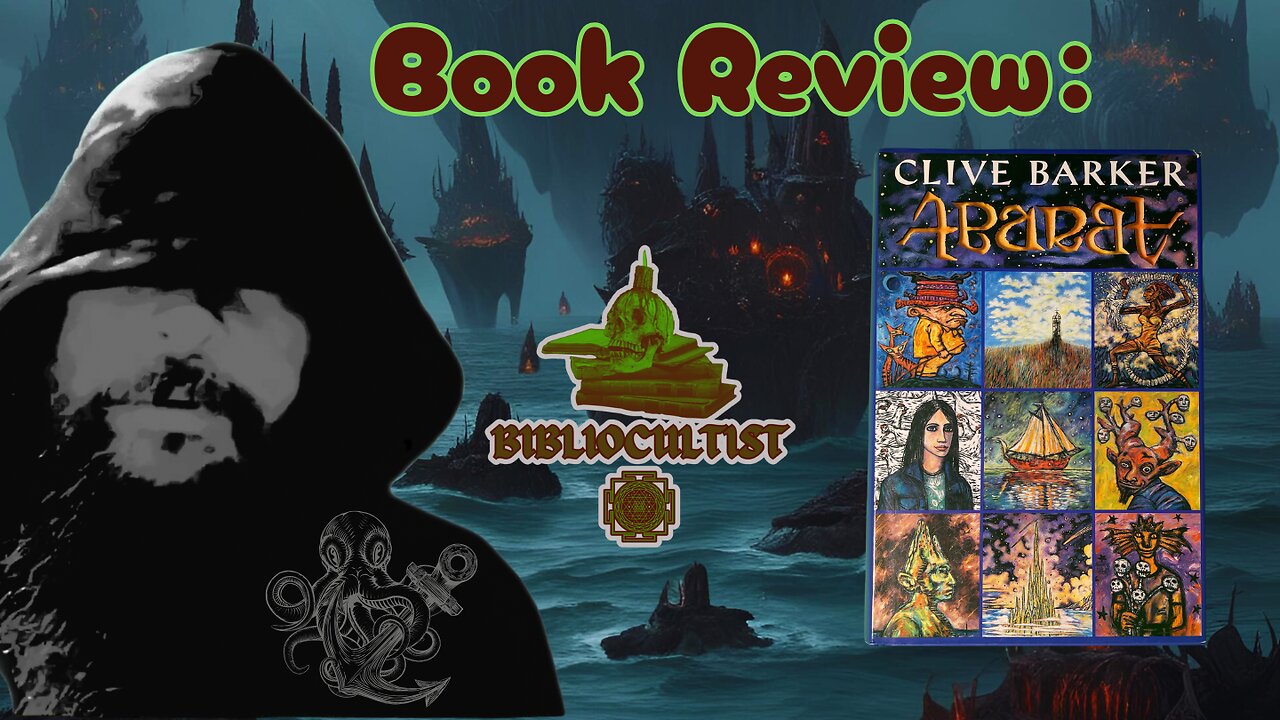Premium Only Content

Abarat: Clive Barker's Dreamlike Children’s Masterpiece
*CHECK OUT MY MERCH: https://bibliocultist.printful.me/*
In this spoiler-free #bookreview and #bookrecommendation, I explore Clive Barker's fantasy novel 'Abarat', the first book in a series. I praise its unique blend of existential dreamscapes, sorcery, and alchemy, noting it's not overtly horror-focused like Barker's other works. The book features around 300 beautiful oil paintings by Barker himself, adding a visually stunning element. The story follows Candy, a young girl transported to the fantastical world of Abarat, where the stars are different, adding cosmic strangeness. I enjoy the book's melancholic yet imaginative tone, with Barker cleverly weaving the fantastical into the tapestry. A poem called 'Where is When?' captures the contrasting natures of day and night. Overall, Abarat offers a unique and beautifully illustrated fantasy experience that blends existential themes with imaginative worldbuilding.
*all music and content copyright BiblioCultist.com*
#booktube #books #clivebarker #abarat #fantasy #dreamscapes #sorcery #alchemy #artwork #oilpaintings #candy #melancholic #imagination #biblio #cultist
**SHOW NOTES**
1. Clive Barker is a British author, filmmaker, and artist known for his dark, imaginative works in the horror and fantasy genres. He gained widespread recognition with his series of short stories, *The Books of Blood*, which established him as a master of modern horror. Barker's unique vision blends visceral, often graphic depictions of horror with richly detailed worlds and deep philosophical themes. Beyond literature, he directed the cult classic film *Hellraiser*, introducing audiences to the enigmatic character Pinhead. His influence on horror continues to inspire writers and filmmakers worldwide.
2. The concept of an alternative world in fantasy literature began to take shape in the late 19th century with works like William Morris's *The Well at the World's End*. This novel is often credited as one of the earliest examples of a fully realized secondary world, complete with its own geography, history, and cultures. While later authors like J.R.R. Tolkien expanded on this idea in *The Lord of the Rings*, Morris's work laid the foundation for creating immersive fictional realms distinct from our own. His innovation inspired generations of writers to explore the possibilities of alternative worlds, shaping the fantasy genre into what it is today.
3. Stellar religions, such as certain Egyptian cults, often focus on the stars and their perceived influence on human life, destiny, and the cosmos. These religions typically emphasize the cyclical nature of existence, linking stellar movements to agricultural cycles, fate, and the afterlife. Unlike solar religions, which center on the sun as a symbol of power, life, and vitality, or lunar religions, which highlight the moon’s connection to fertility, time, and mystery, stellar traditions are more concerned with the vastness of the heavens and their divine order. For example, the ancient Egyptians revered stars like Sirius, associating them with renewal and divine favor. Stellar religions often reflect humanity's attempt to find meaning in the infinite and the eternal, contrasting with the more immediate, life-sustaining qualities celebrated in solar and lunar worship.
4. The division of the hours, known as the Liturgy of the Hours or Divine Office, is an ancient Christian practice rooted in the Jewish tradition of praying at fixed times of the day. It structures daily prayer into specific intervals, such as Matins (morning), Lauds (dawn), Vespers (evening), and Compline (night), creating a rhythm of worship that sanctifies the day. This practice emphasizes the belief that prayer should permeate all aspects of life, offering continual praise to God. Monastic communities, especially, have preserved this tradition, using psalms, hymns, and readings to mark each hour. By dividing time into sacred moments, the practice reflects a deep connection between the spiritual and the temporal, reminding believers of the constant presence of the divine in their lives.
5. The concept of yin and yang is a fundamental principle in Chinese philosophy, representing the dualistic nature of existence. Yin symbolizes qualities such as darkness, passivity, and receptivity, while yang embodies light, activity, and assertiveness. These two forces are interconnected and interdependent, constantly balancing and transforming into one another, reflecting the harmony and dynamic equilibrium of the universe. Neither is inherently good or bad, as both are necessary for the functioning of life and the cosmos. This philosophy emphasizes the importance of balance, illustrating how opposing forces coexist and complement each other to create wholeness.
-
 LIVE
LIVE
DeVory Darkins
1 hour agoDemocrat Voters get CRUSHING NEWS as Trump celebrates MAJOR TRADE DEAL
18,425 watching -
 1:05:34
1:05:34
Timcast
2 hours agoDemocrats SUE, Trump USDA Says ITS DONE, No Food Stamps Will Come, Riots Feared
123K126 -
 LIVE
LIVE
The Charlie Kirk Show
1 hour agoProud to Be American? + VA and NJ + Charlie's Education Vision | Maloney, Arnn | 10.29.2025
3,886 watching -
 38:32
38:32
Code Blue Cam
2 hours agoHow Police Stopped a Potential Church Massacre...
22 -
 2:04:24
2:04:24
Steven Crowder
4 hours agoShutdown Backfire: Dems Are In Major Trouble While Trump Takes on the World in Asia
298K226 -
 LIVE
LIVE
Sean Unpaved
1 hour agoBLUE JAYS SHOCK THE WORLD: Series Tied!, NFL Deadline Meltdown + NBA's Cup Chaos Begins
68 watching -
 1:05:30
1:05:30
The Rubin Report
3 hours agoZohran Mamdani Forced to Explain Why He Lied as Media Turns on Him
25K36 -
 LIVE
LIVE
Dr Disrespect
2 hours ago🔴LIVE - DR DISRESPECT - BATTLEFIELD 6 - REDSEC DUOS - WIN WIN WIN
2,130 watching -
 LIVE
LIVE
Side Scrollers Podcast
3 hours agoAngry Joe’s TDS/Halo Meltdown + Console War is OVER + Twitch Staff FIRED + More | Side Scrollers
703 watching -
 LIVE
LIVE
The Shannon Joy Show
2 hours agoThe Persecution Of Reiner Fuellmich - The World’s Original COVID Whistleblower! With Human Rights Advocate Seba Terribilini
229 watching